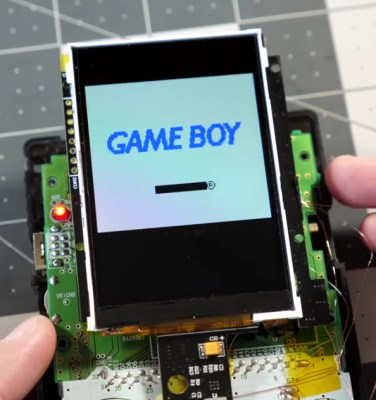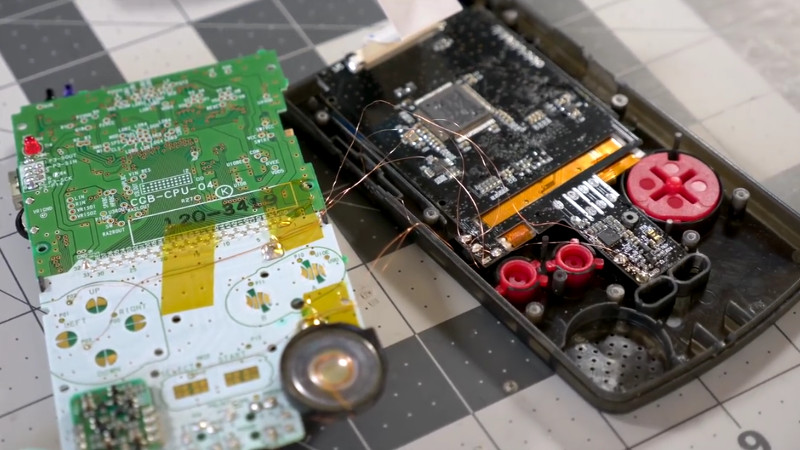Early last year, a very unique Game Boy Color showed up on Chinese shopping site Taobao. Rather than the rather anemic-looking display of the original GBC, this version was modified with a modern IPS LCD. Even in the pictures shown on the product page, it was clear the display on this unit was far more advanced than anything Nintendo ever packed into a Game Boy. The retro gaming community went wild, and soon the site was overwhelmed with orders. The majority of the sales were canceled by the seller, and it’s believed as few as 75 of these hacked GBCs were actually shipped out.
 Thanks to one of his viewers, [Colin] was able to get his hands on one of these extremely rare customized handhelds. Clearly a man after our own heart, his first inclination was to tear the thing apart and see how they built it. While he had a fairly good idea of how they managed this hybrid of modern and classic technology, there were a couple of surprises inside.
Thanks to one of his viewers, [Colin] was able to get his hands on one of these extremely rare customized handhelds. Clearly a man after our own heart, his first inclination was to tear the thing apart and see how they built it. While he had a fairly good idea of how they managed this hybrid of modern and classic technology, there were a couple of surprises inside.
The device has a completely stock main board, and as such works and plays like a normal GBC. But upon flipping the main board over, [Colin] found a nest of thin magnet wire connecting the new display controller to individual buttons on the front panel. As he later confirmed when he reassembled the system, this allows the user to adjust the display’s brightness by holding “Select” and using the directional pad.
As for the screen itself, the big surprise was that it’s clearly pulled out of a relatively recent smartphone. The screen is physically much larger than the opening in the GBC’s front panel, but through some software trickery the image is displayed only in the area that’s visible to the player. [Colin] managed to get a hold of a few contacts “in the know” who confirmed to him that both the hardware and software for the display controller were specifically created for this application, and are unlikely to be duplicated by anyone else.
Considering most of the Game Boy hacks we cover are about somebody jamming modern hardware into them, it’s an interesting change of pace to see a group that was so adamant about retaining as much original hardware as possible while still managing to improve the user experience.
[Thanks to Doc Oct for the tip]
















Hopefully someone digs deeper and figures out how to replicate this.
Or the seller starts mass producing them….
90% sure it is some off-the-shelf FPGA, and the software is in the small SOP-8 package.
I bet it’s a similar idea to this: https://hackaday.com/2009/11/26/ds-goes-full-size-pockets-everywhere-rally-in-protest/ The unmarked chip could be an FPGA that reads the LCD commands from the Gameboy and translates into the appropriate commands for the new LCD.
“The device has a completely stock main board, and as such works and plays like a normal GBC.”
First sentence of the third paragraph. Come on guy.
Key component of that statement being “main board.” The LCD is controlled via secondary board connected via ribbon cable to the main board.
Honestly finding IPS panels of any quality is going to be the limit here. TN screens are easy to find but i can never find IPS screens. The rest of the magic is likely in that FPGA as others have commented.
You could also check BennVenn, he does a similar mod putting AGS-101-screens into GBCs using a ribbon cable he made for that reason specifically. He also sells those and there are even a few resellers, i think (like deadpanrobot). So… go and do this. Or get one from BennVenn. ;)
Ahh the joys of buying from Chinese sellers / resellers / hype machines / complete liars. At least they usually eventually refund you when the “suggested pricing” turns into something they don’t like and was just meant to draw you into purchasing or that they never even had stock of to begin with and they now suggest you buy the other product they have for sale instead. Or what they have isn’t really what they said they did so they sent you something in exchange and hope you don’t notice. Or it’s totally bogus to begin with and they just don’t care.
Plus, it is all in Chinese so the language barriers can be….. an extra layer of frustration to not fluent speakers.
Like many of the products there, this rather neat item that somebody clearly put a great deal of time into also strikes me as unlikely to be an official Nintendo unit. Not like that seems to matter to the sellers.
Frankly though, the depth of what you can find on that site can be really absurd and the pricing, even after customs and a month of subsidized shipping can still be pretty remarkable.
I wonder how this is not a simple thing to just order from Ali…
Can’t either be super fast or super secret in terms of protocol. Or is it?
At the end of the video he mentions there are (relatively) cheap and easily sourced adapters that let you go from the original GBC screen to a modern LCD of the same resolution. So the hardware side isn’t a complete mystery, at least.
But the trick here is that it’s doing up-scaling and even positioning the image at a certain point on the screen. That plus the OSD means there’s a considerable amount of software side stuff happening here.
What I find specifically odd is that all the software work was done to only part with about 75 units. Why go to such great lengths to sell such a small inventory off and leave no documentation anywhere for be found. *This* is what I hate about Chinese products. They inevitably break laws in order to generate capitol and some of these products are great but they can’t reveal anything because they clearly ripped off someone’s work.
There are the GB-BOY games which work fine, but use a regular backlit colour LCD with bad viewing angle. Though they use diagonal pixels so some graphics are a bit off in the translation
This: “[Colin] managed to get a hold of a few contacts “in the know” who confirmed to him that both the hardware and software for the display controller were specifically created for this application, and are unlikely to be duplicated by anyone else.”
plus this: “The majority of the sales were canceled by the seller, and it’s believed as few as 75 of these hacked GBCs were actually shipped out.”
equals: You can get completely custom hardware and software, have it manufactured at itty bitty scale to fit into a GBC-sized case, turn around and sell just 75 of them, and somehow turn a profit?!
Well, apparently they were selling for upwards of $400 USD, so that could have something to do with it.
That totals a resonable amount, but surely if they turned out to be that popular at that price, selling a few more than 75 would be a license to print money! Why would you not do it?
I can see a hacker might make one or two for fun, writing software, customising hardware. That’s what hackers do. Perhaps said hacker gets bored of it and decides to sell their one-off. But to make 75 and then quit?
The video shows a Taobao listing for 880 CNY which in Feb 2017 would have been about 130 USD. The 400 USD price was the eBay reseller.
It’s bizarre, because the screens are surely scrap, or end of line, or scavenged from some other project. Otherwise they’d just use a simple, much cheaper screen of the right size and resolution. So the parts must’ve been virtually free, enough that they could pay the guy to write the FPGA code. Although a certain amount of that code might’ve been ripped off from Gameboy emulators. Sure VHDL isn’t the same as actual C software but I bet you could adapt from it.
It’s such a weird thing. Even if you wanted to sell a handheld with a really nice screen, you’d still buy one the right size. And you’d probably just use an ARM core with the usual emulators bunged on it for lots of other consoles too.
So the custom screen interface (and the really weird magnet wire job) must’ve been the only parts needed new. Cheap enough to make it worthwhile to reuse the old scrap. Products being created just to use up scrap aren’t rare from China.
Hm, still, you’d think their FPGA experts would be better put to use cracking the Nintendo Switch for pirate devices.
This seems like something you could pull off in an ice40 FPGA without any custom silicon…
An ice40 1k can fit a j1a swapforth CPU (and little else), but a 4k could almost definitely handle this… a small picorv32 might also fit but would leave a bit less headroom.
You know your onions, sir.
Knowing this community it will be replicated in a week or two.